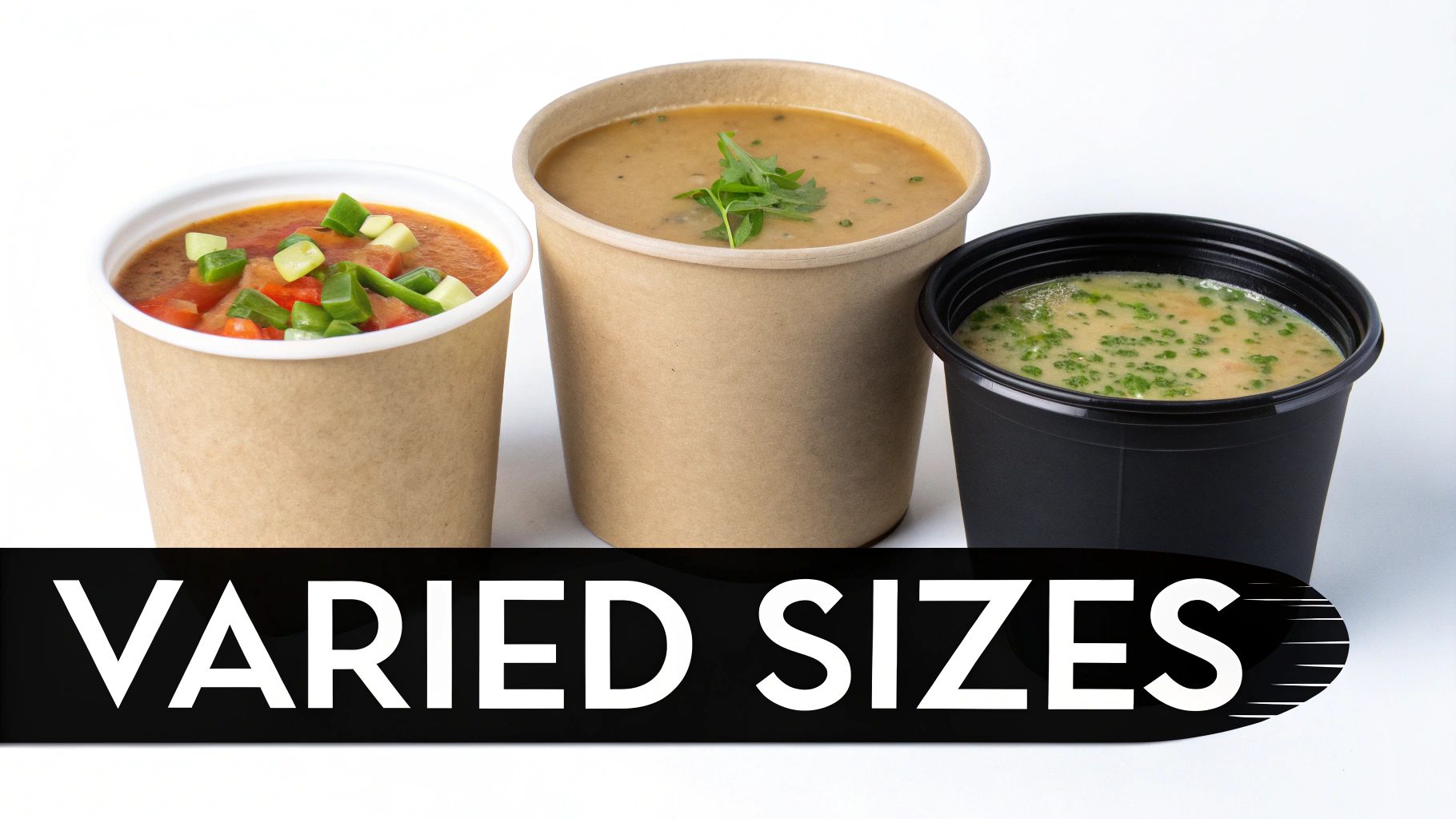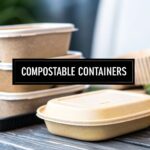Why Quality Soup Containers Transform Food Service Operations
Choosing the right disposable soup container can significantly impact your food service operation. This seemingly small detail can influence everything from customer satisfaction to the efficiency of your workflow. It can even affect repeat business and brand loyalty. So why are leading food businesses choosing specialized disposable soup containers with lids instead of generic options?
Imagine a customer receiving a spilled, lukewarm soup order. This negative experience can damage your reputation and discourage future orders. On the other hand, a securely sealed, temperature-controlled container delivers a positive message, reinforcing quality and care. This small investment in quality packaging can directly translate into increased customer loyalty.
Additionally, consider the operational advantages of efficient, leak-proof containers. These containers can streamline packing processes, minimize spills, and reduce waste, contributing to a smoother workflow.
Impact of Container Quality on Customer Experience
Quality disposable soup containers with lids are essential for maintaining optimal temperature and preventing leaks. Both factors heavily influence the customer experience. A hot soup arriving cold, or a leaky broth seeping through the packaging, can easily ruin a meal.
This not only leads to immediate customer dissatisfaction but also reflects poorly on your business overall. Choosing a container that effectively retains heat and prevents leaks is a fundamental step in creating a positive customer experience and building repeat business.
This focus on quality and convenience aligns with current market trends. The disposable food containers market, including disposable soup containers with lids, is growing significantly. In 2024, global revenue was approximately USD 18.54 billion, with projections indicating a rise to about USD 19.36 billion in 2025. Experts predict this market will reach USD 29.77 billion by 2035, demonstrating a CAGR of 4.4% from 2025 to 2035.
Investing in high-quality containers directly improves customer satisfaction and positions your business for success in this expanding market.
Efficiency and Cost Savings With High-Quality Containers
Beyond customer satisfaction, high-quality containers offer practical benefits for food service operations. Durable, leak-proof containers minimize spills and waste, reducing cleanup time and the expense of replacing damaged goods.
This results in increased efficiency and contributes to a healthier bottom line. The right container choice can simplify storage and transport, optimizing workflow and reducing operational overhead.
By proactively preventing problems, quality disposable soup containers with lids are a smart investment. They streamline processes and enhance overall operational efficiency.
Material Matters: Choosing the Right Container Composition
From hearty stews to delicate broths, the material of your disposable soup containers with lids plays a vital role in preserving both soup quality and brand perception. Choosing the right material involves balancing practicality, cost, and environmental impact. Let’s explore the key differences between common container materials and how these differences affect your business.
Understanding the Material Options
Disposable soup containers with lids typically come in various materials, each with its strengths and weaknesses. Let’s examine a few popular choices:
- Plastic: Traditional plastic containers offer excellent leak resistance and are generally cost-effective. However, their environmental impact is a growing concern.
- Paper-based: Modern paper-based containers, often lined with a thin plastic layer, provide a more eco-friendly option while still offering decent leak resistance. However, they may not retain heat as effectively as plastic.
- Plant-based: Emerging plant-based alternatives, made from sugarcane or bamboo, offer a renewable and compostable solution. These options can be more expensive but align with the increasing consumer demand for sustainable packaging.
To help visualize the key differences between these materials, take a look at the comparison table below:
| Material Type | Heat Resistance | Leak Resistance | Environmental Impact | Cost | Best For |
|---|---|---|---|---|---|
| Plastic | Excellent | Excellent | High | Low | Budget-conscious businesses prioritizing functionality |
| Paper-based | Moderate | Good | Moderate | Medium | Businesses seeking a balance between cost and environmental responsibility |
| Plant-based | Moderate | Good | Low | High | Businesses prioritizing sustainability and premium image |
This table compares different materials used for disposable soup containers with lids, considering heat resistance, leak resistance, environmental impact, cost, and ideal applications. As you can see, each material presents a unique set of advantages and disadvantages.
Impact on Food Quality and Customer Perception
The container material directly impacts the temperature, texture, and overall quality of your soup upon arrival. A well-insulated container keeps soup hot during delivery, enhancing the customer experience.
The infographic above highlights the importance of a secure seal. A proper seal prevents leaks, maintains temperature, and safeguards food quality. This attention to detail demonstrates a commitment to quality.
Additionally, the material choice influences customer perceptions of your brand. Eco-friendly materials, like plant-based options, showcase your commitment to sustainability. Conversely, using traditional plastics might be perceived negatively by environmentally conscious customers.
Market Trends and Growth
The demand for disposable soup containers is linked to the broader food storage market. The food storage container market, which includes these soup containers, is experiencing significant growth. It was valued at approximately USD 163.5 Billion in 2024 and is projected to reach about USD 247.29 billion by 2034, growing at a CAGR of 4.5%. The increasing need for convenient and reliable food storage and transportation drives this growth.
Choosing the Right Material for Your Needs
The “perfect” material depends on your operational needs and priorities. Plastic might be the most viable option if cost is a primary concern. However, if sustainability is a core brand value, plant-based materials offer a compelling, albeit more expensive, alternative. Consider factors like the type of soup, your delivery method, and your target audience to select the material that best meets your unique requirements.
Finding Your Perfect Size: Beyond Standard Measurements
Choosing the right size for your disposable soup containers with lids isn’t just about selecting a volume. It’s a crucial decision impacting your entire operation, from portion control and customer satisfaction to storage and delivery logistics. That’s why leading restaurants often use various sizes instead of a one-size-fits-all approach.
A single size likely won’t suit both a small cup of soup and a large bowl of stew. Offering different sizes lets customers choose portions fitting their needs and appetite, enhancing their experience. This also allows for more strategic menu pricing.
Varying sizes also influence customer perception of food quality. A small portion in a large container can appear skimpy and unsatisfactory. The right-sized container creates a visually appealing and satisfying presentation. This attention to detail significantly impacts customer perception and encourages repeat business.
Optimizing Size for Operational Efficiency
Your disposable soup container size also affects back-of-house operations. Consider storage and transport. Different container dimensions affect stacking and storage efficiency, maximizing valuable space.
This extends to delivery efficiency. Standardized sizes make packing and transport easier, especially for delivery services with limited vehicle space. The right container maximizes orders per delivery, reducing costs and improving efficiency.
Matching Size to Menu and Service Model
The optimal container size often depends on your menu items and service model. Quick-service restaurants might prioritize smaller, easily handled containers. Upscale takeaway concepts might benefit from larger, more elegant presentation-focused options.
A 12-oz container might be perfect for a side of soup, while a 16-oz or 24-oz size suits a main course. Understanding these nuances lets you tailor container choices to your target audience and dishes.
Heat Retention and Container Dimensions
Your disposable soup container’s dimensions also influence heat retention. Wider containers may cool faster than narrower, taller ones due to increased surface area exposure. This is crucial for maintaining serving temperature, especially during delivery.
Choosing the right size involves balancing portioning, presentation, storage, and heat retention. Considering these factors optimizes container selection beyond volume, improving customer satisfaction and streamlining operations.
Sustainable Solutions: Navigating Green Packaging for Soup
Consumers and regulators are increasingly concerned about the environmental impact of disposable soup containers with lids. Moving beyond simple “greenwashing” to truly sustainable solutions is crucial. This means understanding the differences between biodegradable, compostable, and recycled materials, and how they perform in real-world food service.
Biodegradable, Compostable, and Recycled: Defining the Terms
These terms are often confused, but they have distinct meanings. Biodegradable materials decompose naturally, but not always into environmentally friendly substances. Compostable materials break down into organic matter, enriching the soil. Recycled materials are made from previously used products, reducing the demand for virgin resources. The best choice depends on local waste management and your sustainability goals.
Performance Matters: Evaluating Eco-Friendly Options
A common concern about eco-friendly disposable soup containers is their performance. Can they handle hot soup without leaking? These are important questions, and the answers vary based on the material and manufacturing process. Some plant-based containers now offer similar heat resistance and leak protection to plastic, while others are better for cold or room-temperature foods. Careful evaluation is key to finding solutions that meet both environmental and operational needs.
Sustainability as a Marketing Asset
Adopting sustainable packaging isn’t just environmentally responsible; it’s also good business. Consumers are actively seeking eco-conscious brands. Showcasing your commitment to sustainability can be a powerful marketing tool, boosting customer loyalty and brand differentiation.
The market for disposable food packaging, including soup containers, is growing rapidly. It’s expected to increase from USD 73.10 billion in 2025 to USD 140.15 billion by 2034, with an annual growth rate of about 7.5%. This growth is driven by the demand for convenient, hygienic, and sustainable options.
Leading food services are using their sustainable packaging choices to connect with eco-conscious consumers, building brand loyalty and reducing their environmental footprint. Successful sustainable packaging implementation requires balancing performance, cost, and environmental impact. By carefully considering options and prioritizing solutions that deliver on all fronts, businesses can contribute to a greener future while strengthening their brand and bottom line.
Strategic Selection: Matching Containers to Your Business Model
Finding the perfect disposable soup containers with lids isn’t about chasing the latest trends; it’s about choosing what truly aligns with your business. A closer look at successful food service operations reveals how container selection directly impacts both customer perception and operational efficiency.
Container Features and Business Needs
Certain container features hold more weight for some businesses than others. For example, delivery services place a premium on leak-proof containers with excellent heat retention. This ensures soups arrive at the customer’s door piping hot and spill-free. Conversely, a dine-in restaurant offering takeout might prioritize presentation and ease of handling for customers carrying their soup home.
Leading ghost kitchens, focusing exclusively on delivery, optimize container selection differently than established restaurant brands. They prioritize efficiency and cost-effectiveness, often selecting stackable, easily sealable containers that maximize kitchen and delivery space. Established brands, on the other hand, often emphasize branding and a premium presentation. Features like custom printing or high-quality materials can noticeably impact repeat business and customer satisfaction.
Creating a Decision-Making Framework
A practical framework simplifies evaluating disposable soup containers with lids. Consider your unique operational demands:
- Temperature Retention Time: How long must the soup stay hot? This is critical for delivery services.
- Leak Prevention: How important is preventing leaks, especially during transport?
- Branding Opportunities: Do you want custom-printed containers to strengthen brand identity?
- Ease of Handling and Storage: How easy are the containers to store, stack, and manage for both staff and customers?
- Environmental Impact: Do you value eco-friendly materials like biodegradable or compostable options? When considering eco-friendly options, explore other areas; for instance, sustainable options can also be found among sustainable promotional items.
- Cost: Strike a balance between quality and affordability.
To illustrate how these factors influence different business models, review the following table:
Business Needs and Recommended Container Solutions
| Business Type | Primary Needs | Recommended Container Type | Size Options | Material Considerations |
|---|---|---|---|---|
| Food Truck | Durability, portability, ease of handling | Sturdy, leak-proof containers with secure lids | 8oz, 12oz, 16oz | Microwave-safe plastic or paper-based |
| Ghost Kitchen | Stackability, efficiency, cost-effectiveness | Stackable, sealable containers | 16oz, 24oz | Plastic or plant-based |
| Fine Dining Takeout | Presentation, premium quality, brand reinforcement | Elegant, high-quality containers with custom branding | 12oz, 16oz | Plant-based or premium paper-based |
| Casual Dine-In with Takeout | Versatility, ease of use, customer convenience | Microwave-safe, lidded containers | 8oz, 12oz, 16oz | Plastic, paper-based, or plant-based |
This table demonstrates the link between business type and container choice. By aligning your container selection with your specific needs, you ensure your packaging supports your business goals and enhances the customer experience.
Operational Excellence: Mastering Container Management
Beyond selecting the right disposable soup containers with lids, proper handling and storage are essential for food safety, efficient operations, and maintaining product quality. Overlooking these seemingly minor details can lead to costly problems like contamination, damaged goods, and workflow disruptions.
Optimizing Storage for Maximum Efficiency
Top-performing restaurants recognize the value of efficient storage. They design their storage systems to maximize space utilization while ensuring FIFO (First-In, First-Out) stock rotation. This method minimizes waste by using the oldest inventory first and preserves container quality by preventing damage from extended storage.
Think of it like organizing your pantry at home. Items tucked away in the back are often forgotten and expire before those at the front. FIFO rotation applies this same logic to disposable soup containers with lids, reducing spoilage and wasted resources.
Furthermore, storage conditions play a significant role in container quality. Humidity can compromise paper-based containers, while temperature extremes can affect the integrity of bioplastics. Proper storage mitigates these risks and ensures containers perform as expected.
Streamlining Workflow and Maintaining Hygiene
Efficiently incorporating disposable soup containers with lids into your workflow is crucial for minimizing handling time and maintaining hygiene. Designated storage locations, accessible filling stations, and clearly defined handling procedures can significantly reduce contamination risks and accelerate packing processes.
For instance, pre-portioning ingredients and placing containers near the filling area can drastically reduce preparation time. This not only improves speed but also allows staff to prioritize safe handling and proper sealing techniques. Such a streamlined approach minimizes errors and the risk of cross-contamination.
Filling Techniques for Optimal Results
Even the filling process itself can influence soup quality and container performance. Specific techniques, such as leaving a small headspace to avoid overfilling and ensuring a secure seal, can prevent common issues like leaks, condensation, and spills.
Proper sealing is especially critical. A secure lid prevents leaks, maintains temperature, and protects against contamination. This attention to detail safeguards food quality and enhances the customer experience by demonstrating a commitment to care and quality.
These operational best practices, from efficient storage to meticulous filling, enhance the customer experience and optimize kitchen operations. These improvements provide a tangible advantage for your business, going beyond simply choosing the right container.
Ready to enhance your food service operation with high-quality, reliable disposable soup containers and other packaging solutions? Visit MrTakeOutBags.com today to explore our wide selection of products designed for food service professionals.






Comments are closed.